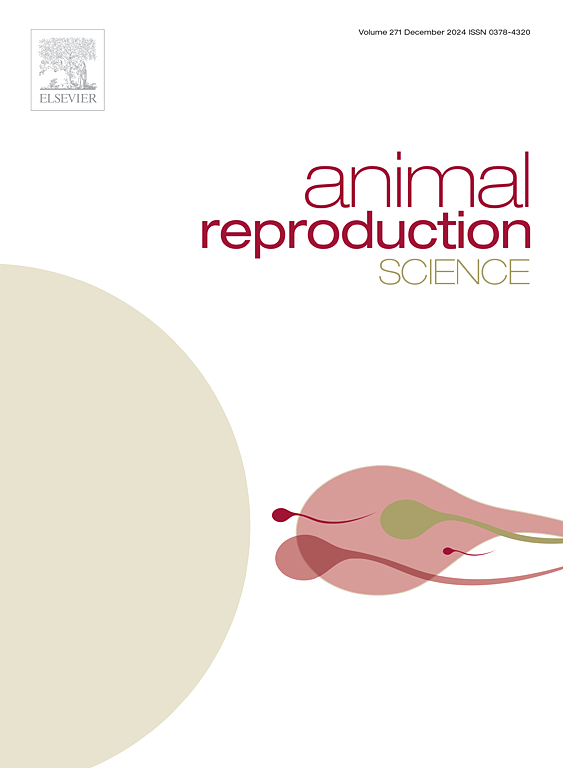高通量测序数据揭示绵羊怀孕早期不同时间点血浆细胞外囊泡内微量 RNA 的差异
IF 2.2
2区 农林科学
Q1 AGRICULTURE, DAIRY & ANIMAL SCIENCE
引用次数: 0
摘要
外泌体 microRNA 对基因转录和表达至关重要,可影响目标基因。它们可能在动物模型和人类妊娠过程中发挥直接或间接的作用。本研究旨在全面探讨绵羊早孕期血浆外泌体miRNA的表达谱。本研究特别探讨了中国美利奴羊和萨福克羊血浆外泌体 miRNAs 的表达差异。研究的主要重点是清楚地阐明血浆外泌体miRNA的变化,找出可能对早孕产生影响的潜在生物标志物,并深入探讨其生物学功能和可能的潜在分子机制。将中国美利奴羊和萨福克羊分为两组,每组20只,进行人工授精。人工授精后五周进行超声波诊断。每组选取三只妊娠羊,从血浆中分离细胞外囊泡衍生的 miRNA。高通量测序确定了差异表达的 miRNA,并利用生物信息学方法分析了它们的靶基因。在两个品种的所有绵羊妊娠早期不同时间点的血浆外泌体样本中,成功鉴定了累计80个已知的miRNA和182个新的miRNA。与妊娠第 0 天的对照组相比,这两个品种的绵羊都出现了六种已知 miRNA 的差异表达:四种上调,两种下调。路径分析将这些 miRNA 与 ECM 受体相互作用、生长激素合成、碳水化合物消化、心肌细胞肾上腺素能信号转导和 MAPK 信号调节等生物过程联系起来。值得注意的是,Oar-mir-27a 在不同时间点在两组之间存在差异。综上所述,本研究对中国美利奴羊和萨福克羊血浆外泌体 miRNA 的表达进行了细致的分析。通过分析,研究人员确定了几种外泌体 miRNA,这些 miRNA 在妊娠早期表现出不同的丰度水平。这些发现有力地表明,这些 miRNAs 有可能成为精确评估绵羊生殖状况的生物标志物。本文章由计算机程序翻译,如有差异,请以英文原文为准。
Differences in microRNA within plasma extracellular vesicles at various time points during early pregnancy in sheep revealed by high-throughput sequencing data
Exosome microRNAs are vital for gene transcription and expression, influencing target genes. They may play direct and indirect roles in pregnancy across animal models and humans. The objective of this research was to comprehensively explore the expression profiles of plasma exosomal miRNAs during the early pregnancy stage in sheep. This study specifically delved into the differences in the expression of plasma exosomal miRNAs between Chinese Merino and Suffolk sheep. The primary focus was on clearly elucidating the changes in plasma exosomal miRNAs, pinpointing potential biomarkers that might exert an impact on early pregnancy, and thoroughly exploring their biological functions as well as the possible underlying molecular mechanisms. Chinese Merino and Suffolk sheep were divided into two groups of 20 for artificial insemination. Blood samples were collected at various pregnancy stages (day 0, day 14, and day 30), Ultrasound diagnosis was carried out five weeks following artificial insemination. Three pregnant sheep from each group were selected for isolating extracellular vesicle-derived miRNAs from plasma. High-throughput sequencing identified differentially expressed miRNAs, and their target genes were analyzed using bioinformatics methods. In plasma exosomal samples derived from all sheep of both breeds at various time points during the early pregnancy stage, a cumulative total of 80 known miRNAs and 182 novel miRNAs were successfully identified. Compared to day 0 gestation controls, both sheep breeds showed differential expression of six known miRNAs: four were up- regulated and two down- regulated. Pathway analysis linked these miRNAs to biological processes such as ECM receptor interactions, growth hormone synthesis, carbohydrate digestion, adrenergic signaling in cardiomyocytes, and MAPK signaling regulation. Notably, Oar-mir-27a differed between the two groups at various time points. In summary, this research meticulously carried out a profiling analysis of the expression of plasma exosomal miRNAs in Chinese Merino and Suffolk sheep. Through this analysis, several exosomal miRNAs were identified, which display distinct abundance levels during the early pregnancy period. These findings strongly imply that these miRNAs have the potential to serve as biomarkers for precisely assessing the reproductive status of sheep.
求助全文
通过发布文献求助,成功后即可免费获取论文全文。
去求助
来源期刊

Animal Reproduction Science
农林科学-奶制品与动物科学
CiteScore
4.50
自引率
9.10%
发文量
136
审稿时长
54 days
期刊介绍:
Animal Reproduction Science publishes results from studies relating to reproduction and fertility in animals. This includes both fundamental research and applied studies, including management practices that increase our understanding of the biology and manipulation of reproduction. Manuscripts should go into depth in the mechanisms involved in the research reported, rather than a give a mere description of findings. The focus is on animals that are useful to humans including food- and fibre-producing; companion/recreational; captive; and endangered species including zoo animals, but excluding laboratory animals unless the results of the study provide new information that impacts the basic understanding of the biology or manipulation of reproduction.
The journal''s scope includes the study of reproductive physiology and endocrinology, reproductive cycles, natural and artificial control of reproduction, preservation and use of gametes and embryos, pregnancy and parturition, infertility and sterility, diagnostic and therapeutic techniques.
The Editorial Board of Animal Reproduction Science has decided not to publish papers in which there is an exclusive examination of the in vitro development of oocytes and embryos; however, there will be consideration of papers that include in vitro studies where the source of the oocytes and/or development of the embryos beyond the blastocyst stage is part of the experimental design.
 求助内容:
求助内容: 应助结果提醒方式:
应助结果提醒方式:


